The Reno Dragon Priest deck is an exciting new addition to the meta from the Mean Streets of Gadgetzan. It uses the new card Kazakus to create potions that can wipe boards and spawn minions for your side. Check out Stonekeep’s in-depth Reno Priest guide that includes Mulligans, Gameplay, Substitutions, and more!
Even though Priest was one of the weakest classes after the Standard rotation that happened earlier this year, state of the class changed a lot this expansion. Priest archetypes that definitely got stronger are Reno Priest and Dragon Priest. So wise Hearthstone players have figured – since both of them got new, shiny, strong cards – why not play both at the same time? And that’s how Reno Dragon Priest was born.
The deck takes best from the both worlds. It can make the aggressive pushes of Dragon Priest, but at the same time it can be defensive and out-heal nearly every deck. The new Priest’s Legendary (Raza the Chained) was made for this deck – you can get a lot of mid game tempo by healing your minions over and over again.
One of the main reasons to play it right now is a solid matchups against Aggro decks (it’s still close to 50/50, but it’s better to have even matchup than to constantly lose) and being a high value counter to decks like Reno Mage or Control Warrior.
UPDATE – RENO KAZAKUS DRAGON PRIEST IN MARCH 2017, SEASON 36
Most successful Reno Dragon Priest lists last month have used the Shadowform, so I feel like adding one would be a good idea. It doesn’t change the gameplay fundamentally, just instead of keeping your minions alive you have an easier way dealing with whatever your opponent plays. Generally, the Hero Power is better, because it’s more proactive – it can give you plays when you have nothing to heal and it can put your opponent on the clock. But that comes for a price of a card and some tempo, which makes it a great option in slow matchups, but not so much in faster ones. Since faster matchups are a bit less common right now, having a Shadowform might increase your overall win rate by a bit.
Changes to the deck:
Check out our List of the Best Standard Decks for Hearthstone Ladder
Reno Dragon Priest Mulligan Guide and Strategy
I’ll divide mulligan section into two – against fast decks and against slow decks. Fast decks are generally the Aggro decks (e.g. Aggro Shaman) or high tempo Midrange decks (e.g. Dragon Warrior). Slow decks are slower Midrange and Control decks.
Vs Fast Decks
Higher Priority (keep every time)
- Potion of Madness – Early game removal, lets you easily kill some of the early game drops if opponents play multiple 1-2 health minions. Great against Pirate decks, you especially if you can charge a Southsea Deckhand into the Small-Time Buccaneer.
- Northshire Cleric – Even though the 1/3 body is not that threatening, you might stop some plays from your opponent. For example, he might not play 1 or 2 attack minion so you won’t get extra card draw. It’s also something to play on turn 1 – in those matchups you won’t need the card draw anyway.
- Twilight Whelp – Most of the time a 2/3 for 1, which is like a better (Zombie Chow. It should get at least one trade, maybe even more if you buff it further or heal it.
- Doomsayer – The best early game card you can get against Aggro. Usually it clears their 1-drop and stalls the game, sometimes if they manage to find the answer, it still tanks 7 damage for 2 mana.
- Shadow Word: Pain – Another early game removal. Even better than the Holy Smite, because it kills pretty much every 1-3 drop and a lot of 4-drops.
- Wyrmrest Agent – Good stats, Taunt, and only for 2 mana. Great early game minion.
- Kabal Talonpriest – In the worst case scenario it’s a vanilla 3/4 for 3. Which is still okay against fast decks, as it gives you a body to trade with. You prefer to keep it alongside other early game minions, but it’s also okay alone.
- Kazakus – Kazakus is a very important card in Aggro matchup, as it has a solid chance to give you AoE, health gain or even both. Dropping it on the curve is a slight tempo loss, but a potion next turn should be more than enough to make up for it.
- Reno Jackson – Reno is a saving grace in a lot of fast matchups. Sometimes turn 6 Reno is auto-win, sometimes it’s even the only way to win. That’s why you want to keep your Reno.
Lower Priority (keep only if certain conditions are met)
- Power Word: Shield – With another early game minion. By itself it might be a dead card in the early game.
- Acidic Swamp Ooze – Keep against decks that play early game weapons, e.g. Pirate Warrior, Aggro Shaman.
- Priest of the Feast or Twilight Guardian – With Coin. It’s too slow to keep when going first, but it gives you a nice minion to coin out on turn 4.
Vs Slow Decks
Higher Priority (keep every time)
- Twilight Whelp, Wyrmrest Agent, Twilight WhelpKabal Talonpriest – Just like vs Aggro decks. You keep them to have some early game plays and solid minion curve. They’re not getting better in the late game, so you might as well play them early.
- Shadowform – Since you don’t mind losing some tempo early in the slow matchups, the sooner you get your Shadowform the better it is in general. Technically the card works best when you have a free Hero Power, but even in the mid game the 2 damage should already be better than 2 healing. You really don’t want to draw this card as one of the last cards, because the later you play it, the less value it gets.
- Kazakus – With this deck, you often go for the mid game tempo win condition in the slower matchups. Then Kazakus on the curve is amazing – you pick a 5 mana potion and you tempo out really well. If you decide to go for the value game, you just keep it until you draw Brann and then combo both.
- Twilight Drake – It’s most likely the best turn 4 play, especially if you will pass some turns. It’s often a 4/6 or 4/7 minion, which should get some solid trades.
- Twilight Guardian – Drake is better on curve, but Guardian is okay too. It also activates your early game Dragon synergies.
- Raza the Chained – The earlier you get Raza, the better it is. Playing it on turn 4 (with coin) or 5 is the best, because you can start getting your Hero Power value sooner.
Lower priority (keep only if certain conditions are met):
- Shadow Word: Pain – Only in the matchups that run early game minions that are good targets. For example, SW:P is a keep against Priest or Warlock (even if it’s Reno), but it’s not a keep against Druid, because he might not play any good SW:P target until mid/late game.
- Acidic Swamp Ooze – Against weapon decks, e.g. Control Warrior. It might not come handy until a bit later, but it’s still better to have it.
- Priest of the Feast – Worse than turn 4 Dragons, because you don’t need healing anyway, but it’s okay keep if you have smooth curve.
Reno Priest Matchup Win Percentages
Here’s a look at how Reno Priest stacks up against other decks in the meta. Thanks to Metastats for allowing us to provide these statistics!
Winrate stats are currently unavailable for this deck at the moment!
Play Strategy
Even though Reno decks are naturally more complicated than non-Reno decks, this one is rather straightforward. There are some combos and interactions to look for, but your general strategy is to curve out well and survive in the Aggro matchups and outvalue the opponent in Control ones.
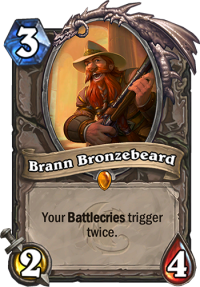
Early game looks similar no matter what deck you’re playing against. You want to drop your minions and control the board. Even in fast matchups, prioritize healing your minions over healing your Hero – most of the time there is no reason to heal yourself. Keeping minions alive means that you can make more trades and prevent way more damage in the long run. Against Aggro, you can play a turn 3 Brann Bronzebeard – it won’t likely get value later anyway and it’s a body on the board (better than passing turn 3). Most of the players are scared and kill it anyway, so it’s like a 2/4 Taunt most of the time. However, against slower decks you wan to keep it for the later combos.
Mid game is where things start to get really different. Against fast decks, your #1 priority is surviving. You don’t have to worry about value, because your deck is slower anyway. That’s why you should pick your Discover options and minion order accordingly. When it comes to Discover, pick the faster things. When you play Netherspite Historian, you want to pick Taunt and if nothing is available, pick a small minion. Picking a late game Dragon is pointless, because it’s too slow to play it anyway. It’s the same with Kazakus – you always go for the 1 or 5 mana spell (depending on your situation), you never pick 10 mana ones. Talking about Kazakus, in fast matchups you prioritize the Armor gain and AoE damage option. 1 mana is 2 AoE damage and 4 Armor gain, while 5 mana is 4 AoE damage and 7 Armor gain. Other okay options are summoning minions or single target damage. Card draw might be solid if you’re digging for Reno. Don’t pick the “add Demons to your hand” option, because there is no Demon that can really help you in fast matchups (maybe Jaraxxus to heal up to 15, but turn 9 is too late most of the time).
If you have a Reno Jackson in your hand, you can play more risky when it comes to your health total. But don’t go overboard – try to count the maximum potential damage your opponent can deal to you every turn and if he MIGHT have lethal, then drop Reno. I’ve got burned a few times, thinking I was safe at over 10 health and then Pirate Warrior played Leeroy Jenkins + 2x Heroic Strike. But overall, as long as you stay alive and remove everything, you should win. One more thing that I want to mention is that if you have board control and you drop Reno, you can just go face. If you give your opponent too much time, he might gather enough damage to kill you even after Reno. But he will need a few turns to pump out that damage, so just put him on a 2-3 turn clock and kill only the highest priority targets. There is no late game against Aggro, so we can drop that – even if the game is longer, you continue to play like in the mid game.
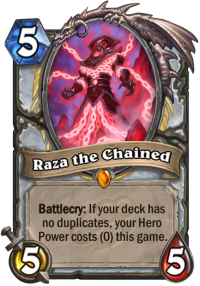
Control matchups are harder to play correctly and that’s what I would like to focus on. First of all, you want to decide on your win condition quite fast. It’s not like you can’t alter it, but it’s better to know early. For example, if you have a great minion curve and your opponent doesn’t play anything, you can go for the tempo game plan and try to kill your opponent way before fatigue. This deck is quite solid at doing that, once you get to the mid game you can play threat after threat while also removing whatever your opponent might drop. I really love Raza when you perform this plan – this way you can squeeze even more tempo every turn by healing your minions all the time. But what’s the deal with deciding on the game plan anyway? See, the thing is – if you pick the tempo win game plan, you want to commit to it. Play things that have higher tempo instead of pure value stuff. You might want to pick a more mid game option from Netherspite Historian or Drakonid Operative instead of a 9-10 drop. You can also drop Kazakus without waiting for the Brann synergy, maybe even go for the 5 mana potion instead of 10. I won a lot of Control games like that. The best thing is that your opponent expects you to play a slow, Control game and you might surprise them this way.
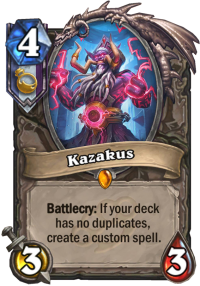
On the other hand, if you don’t get the solid mid game curve, you want to play for the highest value possible. A lot of games vs Control get down to fatigue and in those games every card, every minion etc. matters. You don’t want to draw cards – at least not much. Of course you play the Azure Drake or Power Word: Shield if you get them quite early, but if it’s late game and you’re close to fatigue already, you might opt to not play them at all. +2 health or 4/4 body are often not worth the extra fatigue draw, which can be 7 or 8 damage. You pick the highest value card with Drakonid Operative and Netherspite Historian. If possible, you might want to wait with your Historian to combo it with Brann. The best value turn is Brann + Kazakus + Historian. You pick 2x 10 mana potion with Kazakus. If possible, I like to pick one removal potion and one summoning potion. For example, Mass Polymorph or 6 AoE damage are solid board clears. And summoning an 8/8 and respawning 3 minions that died this game are solid summoning potions. Adding 3 random Demons to your hand is also a consideration, but there is a chance that you will get some small drops which aren’t good. So I pick it only when other options are bad (e.g. card draw + freeze). You really don’t want to pick card draw, because you’re aiming for a fatigue scenario.
Using Shadowform correctly is also important when playing this deck. First of all – in fast matchups, you often don’t play it at all. Sure, you can do that if you have Reno in your hand, but otherwise making you damage instead of heal might be a big problem. In the mid/late game you want to heal yourself for 2 every turn to get out of burn range. With Shadowform, it’s impossible. Yes, theoretically it lets you control the board more easily, but you shouldn’t have any problems with board control in the mid/late game anyway – and early game you won’t be able to afford to lose 5 mana to deal 2 damage (that’s how much it costs you to use your new Hero Power first time after playing the spell). You can use Shadowform in a few cases, though. If you really need to kill something on the board that you have no way to kill otherwise and you really need to kill it. For example, your opponent has a 4/2 minion that you can’t kill this turn and probably won’t be able to kill next one either. If you let it live, it’s 8 damage you’re taking, possibly even more. This makes the loss of heal Hero Power worth it. You can also use it with Priest of the Feast on the board to get extra healing spike when you really need to.
In slower matchups, you really might use it any time you want. If you have nothing else to do on turn 3, you can just use Shadowform. If you don’t count the card and tempo loss, the 2 damage is almost always better than 2 healing. If you draw it later, remember that casting Shadowform resets your Hero Power. It means that if you have enough mana, you can squeeze the last value out of your usual Hero Power, then play Shadowform and Hero Power once again. It’s rare without Raza, but after playing Raza it’s just an extra 2 points of healing you get for absolutely free, so don’t forget about it. Your priority is to attack minions with the Hero Power. Even if you won’t kill something immediately, you can set up to kill it over 2 or 3 turns. Even if you play a minion that directly contests whatever your opponent has on the board, you still want to ping it – e.g. if you play a 3/6 minion vs a 4/3 minion, you still ping the 4/1. Because this way you will be able to kill it next turn if he a) decides to not trade b) removes your minion with a spell etc. So, unless you’re really close to lethal, just ping the minions every time. Over time it will generate a lot of value. It also makes things awkward for the opponent, because it incentivizes him to make bad trades so that you don’t simply kill his minions with Hero Power.
One more bit of advice I want to give for the slow matchups is for before you play Shadowform. If you can choose between playing a new minion and healing something you have on the board to keep it alive, you should generally go for the second option (when playing the value game). The reason is that you have a finite number of threats, so if you can use your Hero Power to basically squeeze more value out of them, it’s worth it.
P.S. Just a friendly reminder – remember that Entombing a minion that you already have in your deck disables “highlander” effects like Reno Jackson until you draw one of the copies.
Reno Priest Matchup Advice
In this section, I’ll give a few quick tips on how to play in the most popular matchups.
Aggro Shaman
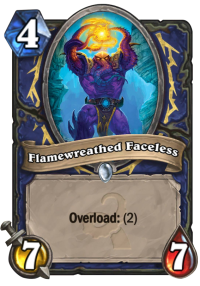
- Reno Priest is a very defensive deck, so it’s optimized well to fight against Aggro decks, including Aggro Shaman. The matchup is in Reno Priest’s favor, but it’s not a huge advantage – you expecto win around 60% of the games, because you don’t always find the right answers and Aggro Shaman with a perfect starting hand is nearly unstoppable.
- Board control is most important. Reno Priest has quite a lot of the early minions, so you should often curve out. Aggro Shaman will still most likely outtempo you, but playing minions is important – even if not efficiently, you might damage or kill something and that’s what matters. There is no way that Aggro Shaman outvalues you in the long run, so as long as you don’t fall too behind, you should be fine.
- DO NOT play Dirty Rat in the early turns – it is pretty likely that your opponent has something bigger like 7/7 or Aya Blackpaw, neither of which you want to see early on the board.
- The deck runs only a single big AoE – Dragonfire Potion. Try to get as much value out of it as possible. Don’t play it on a board with 1-2 small minions unless you absolutely have to. Shaman will be forced to play more minions eventually, because that’s their main way to deal damage. And then you strike with your big AoE.
- In the early/mid game, go for the tempo. After that, try to heal yourself every turn if possible. Raza the Chained obviously comes handy, but even without him, try to spare 2 mana every turn. Your minions are disposable, you can just play more – but if you don’t heal yourself, you can die to the burn.
- Try to go for the 5 mana potion with Kazakus – 4 AoE damage is absolutely the best, then you can get extra 5 damage (that’s good in case Shaman drops the 7/7), 7 Armor or summoning extra stuff. Those are the best potential potions you can get.
- If you survive the early game and stabilize in the mid game, you won the game – Shaman doesn’t have enough value. Even if he gets some Jade cards, he won’t likely ever summon a Jade Golem bigger than a 4/4 or 5/5, which should be quite easy for you to deal with.
Pirate Warrior
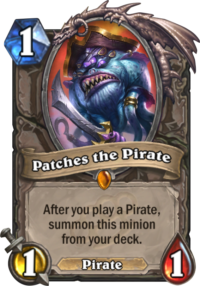
- The matchup is even more extreme than Aggro Shaman. Games against Aggro Shaman often last until late game – games against Pirate Warrior are usually decided much earlier.
- You want to prevent as much damage as possible. Kill every minion, stall the game, AoE everything down even if that clears your own board. Minions pressure from Warrior stops around turn 4-5, after that it’s mostly weapons + burn. Him dropping a single minion on turn 5 or 6 isn’t a threat any more, basically Pirate Warrior doesn’t run any big minions you need to worry about.
- Shadow Word: Death is a great answer to a Frothing. You can trade off something else to make Frothing bigger and then SW:D it. Besides Frothing, it’s often a dead card in this matchup – Warrior mostly runs small minions (up to 4 attack), which are out of range of Death.
- Weapon destruction is important – in the best case scenario you want to destroy Arcanite Reaper or at least Fiery War Axe. But if your opponent plays turn 1 N'Zoth's First Mate, following with an on-curve Acidic Swamp Ooze is the right move – you prevent some damage, you make Small-Time Buccaneer much weaker, you make Southsea Deckhand a vanilla 2/1 instead of a Charge 2/1, you make it awkward to play Bloodsail Cultist etc. If they don’t have another weapon, of course…
- Reno Jackson is basically a win in this matchup. You drop turn 6 Reno, you win 95% of the games. But you should be winning a significant amount of games without Reno too – getting Taunts (Wyrmrest Agent, Twilight Guardian, Chillmaw) can stop a lot of pressure, healing from your Hero Power can eventually get you out of the range if Warrior’s topdecks are pretty poor. 2 healing per turn means that if he draws dead cards (e.g. minions without charge), you can just heal yourself up to a nice health total. Priest of the Feast can get you some extra healing – try to keep whatever spells you have if you already have that minion in your hand. After all, 6 or 9 extra healing is insane in this matchup.
- If Warrior is holding a card, you might want to drop Dirty Rat. If you don’t pull out anything, you get the info that it’s probably a Mortal Strike. You also have a chance to pull out Leeroy Jenkins, kill it immediately and prevent 6 face damage from happening.
- Remember to play around Mortal Strike. Don’t get the Warrior below 12 unless you’re healthy enough to easily survive 2x Mortal Strike + something. Get him down to 13 (or more) and then kill him next turn (by that time you should have big enough board to deal 15+ damage in a single turn).
Dragon Priest
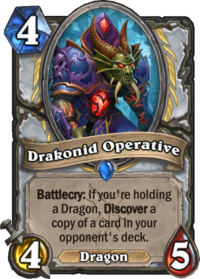
- I have to say that the Dragon Priest should be a favorite in this matchup. Both of you have a similar play style – get ahead on the board, pick the good trades and keep up your minions alive. However, Dragon Priest is better at performing the strategy, because it has a stronger early/mid game. It has more tempo than you do. On top of that, your biggest comeback mechanic – Dragonfire Potion – doesn’t work too well against the deck. Of course, it works both ways – if you get ahead, you should stay ahead, but it’s a much harder task for you.
- What you want in this matchup is a strong minion curve. You want to mulligan all the higher cost cards away – you really, really want to open up with 1 -> 2 -> 3 etc. If you pass for the first 2-3 turns, Dragon Priest can already get a solid advantage. However, in the perfect case scenario, you can get the same curve that Dragon Priest does – it’s just harder, because you run only single copies of each of those cards.
- Kazakus can save the day. This time around, unless it’s absolutely necessary, I like to go for the 10 mana potion. I try to get the Mass Polymorph or at least 6 AoE damage. It gives me the comeback mechanic I need. Because if Dragon Priest will get 2-3 medium/big minions ahead, there is no other way I can win the game.
- Raza the Chained is a great card in this matchup too. If you get ahead or at least stay even, the extra free Hero Power each turn will matter a lot. This matchup is often decided by the mid game tempo and thanks to Raza, you can constantly keep your minions healthy while developing on curve at the same time. If your opponent will want to develop on the curve too, he will have to drop the healing instead.
- Late game should generally go your way. Your deck has more value in total, especially Ysera should get you ahead once you play her. Dragon Priest has zero ways to answer her from the hand and she should just stay on the board, generating value all the time.
Midrange Shaman
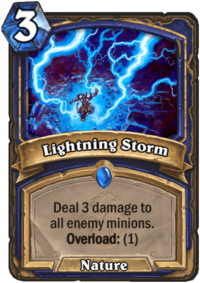
- Matchup against Midrange Shaman is very even and can go both ways. This matchup is all about the board control – neither of you will have a good time playing from behind, so you want to get ahead on the board in the mid game and never let it go. However, it’s kind of problematic, because Shaman has way superior early game with the Tunnel Trogg, Totem Golem and such.
- You want minions – early game minions. However, unlike against Aggro Shaman, you don’t go all in. For example, playing Northshire Cleric just to die to Totem Golem isn’t the best idea. Health, and thus preventing face damage by giving Shaman good trades, isn’t most important in this matchup – you can be at 30, but if you have no board control, you will lose it.
- I’d say that the mid game should generally be in your favor. You should have solid answers for whatever the Shaman plays. But first you need to comeback from the early game disadvantage. It’s pretty hard to do, but Dragonfire Potion is probably the best way to do so. It clears nearly every minion Shaman plays, making it insanely strong removal against the deck – however, since you run only one, you have to use it carefully. I’d say that it’s best to use it after Shaman has overloaded, e.g. with Feral Spirit – after you clear the whole board, he won’t have enough mana to refill and you can get ahead.
- Well-timed Doomsayer can buy you some nice initiative. Try to play it when Shaman has 1, maybe 2 small minions on the board. You don’t want it to die to the Flametongue Totem alone. If Shaman decided to let it go off, you get on the board and now play proactively. If he doesn’t, he will often have to use some resources – maybe even Hex.
- Talking about Hex, don’t rely on your big minions like Chillmaw or Ysera to carry you if Shaman hasn’t used his Hexes yet. Ysera is terrible if it gets Hexed, you pay 9 mana and Shaman spends 3 to deal with it. It’s a huge tempo swing in his favor.
- When it comes to Kazakus, I like going for the 10 mana potion if possible. Even better – go for Brann + Kazakus if you can. Then you can pick one 4 mana for tempo and another 10 mana as a big board clear. 6 AoE damage option is the best – everything in the Shaman’s deck dies to it (maybe outside of a random Ragnaros the Firelord). Especially if you have played Dragonfire Potion already, he might not play around a second big AoE that much and then you can get a lot of value.
- Some Midrange Shaman builds run Bloodlust, so play around it if possible. You want to clear the totems all the time anyway, but Bloodlust damage might be important factor when you wonder whether you need to heal your minions or yourself or even play Reno.
RenoLock
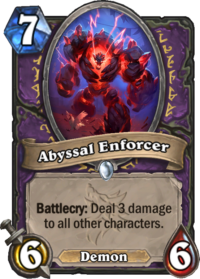
- Reno Priest gets absolutely crushed by RenoLock. It’s one of the worst matchups for the deck. Similarly to Reno Mage, you should be able to outvalue the whole Warlock deck… besides the Lord Jaraxxus. But unlike Reno Mage, you have no way to fight against Jaraxxus, because you have no burst.
- Generally, the matchup starts pretty slowly. You hope that Warlock won’t have one of his big turn 4 plays – Twilight Drake or Mountain Giant. While Giant is an easy Death target, a huge Drake is nearly impossible for the Priest to kill. It will probably get at least 2 for 1 or even 3 for 1 before it dies. Luckily for you, the 4 attack doesn’t line up too well with your turn 4 plays, so that’s some hope. You can also try to go for Kazakus and get the single target Polymorph potion, but it means that you won’t have a big Kazakus turns later.
- More and more RenoLock decks decided to not run the Leeroy Jenkins combo, but frankly it doesn’t matter that much. Your health total isn’t a problem – you can stay at or close to 30 for the most of the game. Actually, if you play the matchup correctly, you should be ahead for the biggest part of the mid game. And I’d say that it’s your best shot at winning the game. Push for as much face damage as possible. Take the trades only if they’re really good for you or to prevent a potential Shadowflame clear. With the Dragon package, you have quite a lot of mid game pressure which you need to use. I won some games against RenoLock because they simply didn’t have Reno to heal after I’ve put pressure on them. Also, in that case, try to finish the game before turn 8 – Twisting Nether turn.
- But that rarely works. So what now? Well, you have a few choices. Brann + Kazakus into 2x 10 mana potion is a good way to have a shot at this matchup. You want to pick the effects that clear and spawn minions, or spawn minions and give them health – you want to run your opponent out of AoE. Twisting Nether and Shadowflame are the only big AoEs available to RenoLock, others are 2-3 damage, so it might not be enough. Respawning 3 minions and giving them all +6 health after RenoLock has gone through his big AoEs can be a great way to win it.
- Yet another way is to just simply keep constant pressure. If you never let Warlock play the Jaraxxus, he won’t outvalue you. If he plays it too late, you might stall the game long enough to make him die out of fatigue.
- If you force a Siphon Soul, Ysera is a good minion to drop – it gets constant value each turn, it’s hard to kill with 12 health and Ysera Awakens is very good in this matchup.
Miracle Rogue
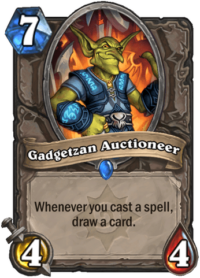
- Another bad matchup for the Reno Priest. Miracle Rogue always had a good win rate against slow decks that struggle once they get completely outtempo’d. Reno Priest is one of those decks. It really struggles once it’s forced to play from behind and it doesn’t have that many ways to clear the board. Rogue, after cycling a lot, can drop a threat after threat after threat and you will eventually run out of answers.
- The key to win this matchup isn’t really outplaying the Rogue. Sadly, it’s mostly about the draws. If Rogue draws pretty poorly and you get a good tempo start, a solid curve – then you can win the game. You really want to stay ahead on the board basically all the time. What Rogue had bad time with is dealing with multiple mid-sized minions. Many small minions, they can Fan of Knives. One bigger minion, they can Sap. So always try to play multiple mid-sized minions. E.g. instead of playing a single Drakonid Operative, it might be better idea to play Wyrmrest Agent + Kabal Talonpriest – you get the same amount of attack, but it’s way harder to deal with for the Rogue.
- Gadgetzan Auctioneer is the biggest threat. Your deck has almost no way to kill it, since it’s at 4 attack and 4 health it’s out of range of most of your removals. You can pretty much only Entomb or Dragonfire Potion it. It means that even without Conceal, if you don’t have a board that can kill it, it might just stay on the board, which is nearly game over. You really, really hope that either you will have a huge board lead and Rogue will have to play from behind, or he will get terrible draws and you won’t have to worry about Auctioneer.
- Dragonfire Potion, while solid in this matchup, has one big flaw – it doesn’t kill Azure Drake. When you play it, you really want to clear the whole board – after all you spend most of your mana on that, and Rogue might still have a board advantage because of the Drake(s).
- Playing one of the big minions is almost a suicide if you haven’t seen at least one Sap. But sometimes you have to risk it. Ysera is solid if Rogue can’t kill it – not only because it gives you extra cards, which are high tempo, but also because of the 4/12 body that can trade into most of the minions Rogue plays.
- Your win condition in this matchup is usually rushing the Rogue down with your mid game board OR focusing on removing everything Rogue plays and forcing him to make suboptimal plays, because you have a huge board lead. Either way requires you to have a board lead, which is the hard part.
- Try to play around Leeroy burst – while Reno Priest isn’t necessarily weak against this combo, because it’s far from OTK, you still might be caught off-guard. With Leeroy Jenkins, 2x Cold Blood and 2x Eviscerate in the deck, ~15 damage from the hand is quite common.
- When it comes to Kazakus potion choices, two best effects are AoE damage and Polymorph. Both kinda counter the stealthed minions and Poly is also great against a big VanCleef.
- Dirty Rat is very strong in this matchup – if you play it around turn 6-7, it’s very possible to pull out Gadgetzan Auctioneer to immediately kill it. Pretty much the only minion you don’t want to pull is Tomb Pillager and those are often played first – every other minion has some kind of Battlecry, Combo etc. that make it a good target.
Combos and Synergies
Most of the combos in this deck revolved around Brann Bronzebeard. You can combo it with a lot of minions, but it’s best with high value Battlecries like Netherspite Historian or Kazakus. But you can also use him to remove a 4-6 health minion (with Blackwing Corruptor), give something +6 health (with Kabal Talonpriest etc.
Dirty Rat has some combos in this deck. You can play it with Brann to pull out two minions immediately, it’s great if you have a way to deal with them right away. Dirty Rat + Doomsayer is also a quite solid play when your opponent doesn’t have a big board – it’s 13 health in total that your opponent needs to go through to prevent Doomsayer from proccing. If you time it right, it will often go off and make you gain a nice board initiative.
One combo that’s incredibly situational, but can save you sometimes is Chillmaw + Shadow Word: Death. You can immediately kill off your Chillmaw if you’re in a desperate need of AoE. Why would you do that instead of waiting, though? Because of things like Hex, Silence or opponent buffing/healing the minions out of range.
Card Substitutions
I’ll start with the replacements of Legendaries (if you don’t have them) and then proceed to the tech cards.
First thing – Highlander Legendaries, so Reno Jackson, Kazakus and Raza the Chained can’t be replaced. Those cards are the reason you play this deck in the first place. If you don’t have them, you can try normal Dragon Priest, which is definitely a cheaper option.
Chillmaw and Ysera can be replaced by other high cost Dragons. You want to run at least one late game Dragon, but two are preferable. Other options can be Nefarian, Chromaggus, Alexstrasza or Deathwing. If you want a really budget option, you can play Forbidden Shaping in a big Dragon slot, but you need a second one nonetheless.
Brann Bronzebeard, although really strong in slow matchups, can be dropped and replaced by one of the cards I’ve already mentioned (or will mention below).
Now, let’s talk a bit about tech cards. There are some more things that you can play in the deck depending on the decks you face most. Some of the more flexible cards that you can take out of your deck to include techs: Potion of Madness, Northshire Cleric, Brann Bronzebeard, and Chillmaw.
Justicar Trueheart
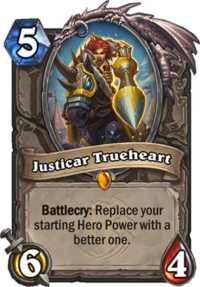
I really love Justicar in this list. In any Reno Priest list, because they run Raza the Chained and those two have insane synergy between each other. However, when remaking the deck a bit, I had to reconsider this choice and play Cabal Shadow Priest instead. The reason is how aggressive the meta is. Most of the decks play quite a lot of small minions, stealing one of them means not only immediately dealing with it, but also having more minions to trade with. It gives you more “immediate” health, unlike Justicar, which is slower.
Justicar is one of the best cards in Control matchups, as it can give you even more healing value. Like trading your minion into a 4 attack one and then healing it back to full right away. I’d love to play both, but that’s even worse right now – having so many big drops is pretty bad in a lot of the matchups.
I feel like Justicar might find a way into the list in case the meta slows down a bit. It’s one of my favorite cards to play in Priest, so I hope that it will happen.
Forbidden Shaping
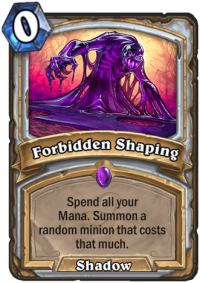
Forbidden Shaping is one of the most flexible cards available to Priest and that flexibility is why a lot of people play it. In faster matchups, you can use it on turn 3 or 4 to spawn something. The minion you spawn will generally be slightly below the curve, but it’s better than passing a turn. It can be played instead one of your big drops – in slower matchups you can wait until late game before you play it, resulting in (most likely) a strong, big threat. And in faster matchup it’s not a completely dead card.
What I kinda dislike about Shaping in this deck is that you can’t easily play it on 8 mana after you drop Raza the Chained. 8 mana slot is better than 10 mana slot in general. 10 mana has a lot of vanilla minions, while 8 has a higher chance of a minion with effect like Ragnaros the Firelord, Ragnaros, Lightlord or Tirion Fordring. But it’s still a good card.
Other Big Dragons
Playing different late game Dragons might not only be a budget necessity, but also a choice. I like the Chillmaw + Ysera duo most in the current meta, because Chillmaw gives you an extra Taunt + AoE (if you manage to survive until turn 7 against Aggro, it can save your skin) and Ysera is hard to remove by a lot of the meta decks and can be an extra win condition in slower matchups. But they’re not the only ones.
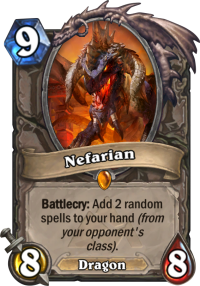
If you want to go for a faster option, pick Nefarian. It has less value potential than Ysera, but it gives the cards immediately, it doesn’t have to stick to the board to get value. 8/8 stats are also more aggressive, which can be fitting in this deck. However, Nefarian is also much easier to remove, for example Dragon Priest can deal with it quite easily (SW:D), but they can’t really deal with Ysera.
Another solid option is Alexstrasza. In slower matchups, it can deal a lot of the damage. It’s amazing against Reno decks, after they drop Reno. It’s 15 face damage with Battlecry. You can also sometimes set up unexpected lethals. If your opponent is at full health, but you have a lot of damage on the board, they might not expect what’s coming. And in fast matchups, you can use her for the self-heal. Alexstrasza would be my second choice.
Chromaggus isn’t very good, but it has its merits. You can save Power Word: Shield to get the extra value. You can also combo it with Northshire Cleric, with 0 mana Hero Power you can drop both and get immediate value. I still don’t like it over other Dragons, though.
The last resort option is Deathwing. Surprisingly, it’s not as bad as it looks like in this deck. You often lose games not because you’re outvalued, but because you’re outtempo’d. For example, a Shaman with no cards and full board. If you had Deathwing in such a scenario, sure, you drop your whole hand, but you clear the board and get 12/12. Deathwing is best in the Midrange matchups, but it’s also useful “last card played” in fatigue scenarios. If you play the full value war, after you already play all the other significant cards, you can still drop Deathwing. In such a scenario, it’s often a win – at this stage of the game your opponent won’t likely have a way to deal with it.
Closing
That’s all folks. I hope that you’re going to enjoy the deck as much as I do. It seems really strong in the current, early meta and I hope that it’s going to stay this way.
If you have any questions or suggestions, feel free to leave them in the comment section below. If you want to be up to date with my articles, you can follow me on Twitter.
Good luck on the ladder and until next time!






























/rating_1_half.png)
/rating_2_off.png)
I noticed under the matchup Slow decks keep priority, it says twlight whelp and talonpriest with no space-I’m assuming this was just an accident?
First of all: great guide. And thx to the design it looks really good.
But for me are 7 dragons are too less. I like to play min. 8 better 9. What you think i can change? Also what for dragons in and what out?
Thx in advance
First of all – the deck already plays 8 Dragons 🙂 Whelp, Operative, Twilight Drake, Twilight Guardian, Azure Drake, Book Wyrm, Chillmaw and Ysera. +1 extra from Netherspite Historian
And that’s enough. It’s still very high for a Reno Dragon Priest, because I want to activate the synergies consistently. You can’t put more in a Reno deck simply because there aren’t any other good Dragons you want to play in such a deck. A lot of the lists have been cutting it down to 6, but I think it’s not enough.
You don’t want to play another big Dragon, because the deck has 2 of them already – it would be too greedy to put more. The only extra Dragon you can consider is Faerie Dragon, but it’s not really good in Priest (3/2 stats, you can’t heal it). But there is just not enough space for it. You’d have to play it instead of Ooze or Dirty Rat, and those are much better cards in the current meta.
I love the deck, but at a time like this loosing on miracle rogue and renolock make a deck pointless.
How do you close out games with this deck? I am only lacking Raza but I am hesitant to craft it, it seems like if Ysera gets removed then you pretty much have no more win condition
The Kazakus/ Brann combo is a massive value game closer which can resuscitate Yesra as long as she actually dies on your side of the board without being polymorphed.
I’ve been trying out something similar but don’t run doomsayer as I don’t want it coming back from one of Kazakus’ 10 cost spells and instead include Medivh…
Turn everything on the board into sheep, summon 3 random minions and then a random 10 cost minion in one turn with the potential to do it again next turn? Yes please. :3
Yes, Doomsayer can hurt when it comes to Kazakus ress potion. But I still think it’s wrong to not play him. He’s a lifesaver against Aggro, often wins you the games you would lose otherwise, because you force them to give up the t1/t2 pressure and buy enough time to get to your mid game clears, Taunts and heals.
I just had the greatest RNG happen with this deck.
I used my cabal thingy that lets me discover a card, and discovered the mage card Coldarra Drake.
Turn 5 I played Raza the chained, and turn 6 I played coldarra drake.
I spammed heals on all my minions til they were full, then healed myself until the rope came and my opponent conceded.
I was your opponent
That’s humorously coincidental
I do not have Chillmaw, and I don’t want to craft him because he is about to rotate out if standard. Can I sub in Wraithion?
Also, why no Justicar? I don’t have her either, but most Reno priests I play against run her.
Wrathion isn’t a great card, and it’s definitely not that good in this list. With only 7 Dragons, the chance that he will draw one is low – most of the time it will just draw 1. Instead, I think that you should add something like Nefarian, Alexstrasza or maybe even Ragnaros. You can also try Forbidden Shaping to add a little flexibility.
Why no Justicar – it’s explained in the article. Most of the Dragon Reno Priest lists (those that hit high Legend ranks) don’t run Justicar, they run Cabal Shadow Priest instead – it’s just better in the current meta. Justicar is too slow against Aggro decks, while Cabal Shadow Priest has an immediate impact. If you feel that Aggro is not a problem and you face more Control, you can play Justicar instead.
What’s a good substitute for chillmaw?
It’s listed above, basically any large Dragon or Forbidden Shaping.
OTK Priest is better. It can actually win some games. Drop the dragons, dragons + Reno is just too messy
What do you mean by OTK Priest? I haven’t seen any in a few months at least. You’re talking about the Kripp’s list with Spawn of Shadows?
I don’t think that Reno + Dragons is too messy. I won’t argue that the deck is better than non-Dragons Reno, but the power level is very similar. There are enough strong Dragons available to make a working Reno Dragon deck right now.
Cancer meta is cancer. Good luck once again priest gets shat on by everything
Jade druid? Nope
Pirate Warrior? Nope
Reno lock? Nope
Miracle rogue? Nope
Freeze Mage? Nope
Any shaman ever? Nope
So what does this deck win against? Mate it loses to fucking Dragon Priest
#cantdealplztakemewillingly
It is literally listed in the post that this deck has a solid matchup against Pirate Warrior.
Yeah but its not
It’s not the deck’s fault if you can’t play it properly.
That’s just the truth, Reno priest, even with dragons, is just weak against most of the decks, even against Pirate Warrior. I really enjoy reno priest, but it’s just too much weak at high ranks.
Remember b4 the expansion was out? “OMG, priest will be the new shaman, they will ruin the game”. lol
As much as I enjoy Reno Priest, maybe most of all decks it isn’t tier 1. I think Cruxkid nailed it.
You just stole this guide from reddit and traded 3 minions for garbage that works against lvl 20 and below.
Fuck this site.
Do you want to provide proof of what you are referring to? Are you referring to this: https://www.reddit.com/r/CompetitiveHS/comments/5gmsqc/reno_dragon_priest_guide_mulligan_strategy_stats/ ? Because that’s our guide… I’m only approving this comment to give you a chance to prove your claim.
Have you tried out dirty rat? That card has really destroyed some opponents for me in the control match ups where it pulls out a strong battlecry minion of theirs.
It’s also been really good against many aggro decks because the minions you pull out usually aren’t too big a deal and you have a nice big taunt on your side.
I like to wait until turn 4 sometimes and combo it with a doomsayer if something big comes out, they need 13 damage to kill doomsayer through taunt on turn 4 which is really tough in most cases. and if they cant you may have just killed one of their more important minions just by using a 2 mana minion of your own.
Also has synergy with MCT but I can see you don’t run that anyway.
Great deck, awesome guide! With regards to your tech replacements; which cards should I look to take out if I want to say put in an Ooze? Currently playing the list as you have it, but just want to have that in the back of my mind if I need to make any changes.
Ooze goes in instead of the Faerie Dragon. It reduces the early Dragon consistency a bit, but gives you a way to deal with the weapons (obviously ;p) I think it’s a nice trade. It also helps a bit in RenoLock matchup, because destroying that Jaraxxus weapon is a big deal (you can survive a turn or two longer if you don’t take the extra 20+ damage).
That’s how I’m playing it right now. I was doing fine with Faerie Dragon, but after facing Pirate Warrior and Aggro Shamans all the time, Ooze was a better choice.
Great article as always Stonekeep – keep up the good work!
Do you have any thoughts on what you’d change if you were taking this to Wild?
Thank you! I’ve shared my thoughts about Wild on the reddit, so I will just copy & paste my comment here:
“I don’t really think much about Wild, because it would be just guessing. I have no clue how Wild meta looks like, what people play there at different ranks, if certain techs are necessary or not etc. To really determine which cards would fit there, I would have to playtest it carefully.
But yes, some cards would definitely fit into the deck. I’d 100% play Lightbomb instead of Excavated Evil, the card is so much better. Especially against Giants (2x 0 mana Arcane Giant are really hard to deal with) and Jade decks.
Loatheb too, it’s an amazing tech card. The 5 mana Kazakus potion that spawns stuff + Loatheb would be a great combo, you would be able to flood the board and stop the potential AoE clears. Great finisher in some matchups in which it’s hard to stick the board in (CW, RenoLock).
I’d probably play Dark Cultist instead of Blackwing Tech too. One less health, but a great Deathrattle + doesn’t require Dragon synergy.
Probably Zombie Chow too. Maybe instead of Holy Smite.
And I’d definitely fit Dr. 7 somewhere in there. No way to pass on that card, it’s too strong, especially after the BGH nerf.
Actually, there would be a lot of Wild cards I would want to test in this deck. Vol’jin (probably should leave Holy Smite then, but still great turn 10 removal with Corruptor or Nova), Belcher, Deathlord, Velen’s Chosen.
But like I’ve said, without playtesting it’s mostly just guessing.”
I really don’t understand how you can say this is a 60/40 in favor of Reno priest, even if you get Reno it’s not rare to die turn 5 and the early game pressure is enough to go through the lose ; you can’t comeback even with raza, justicar etc etc, you only die because you receive 20dmg in 5 turn I’m positive at 72% with this deck except with Pirate warrior which I have only 28% winrate over 29 games =/
Sure, you’re right. But I won a lot of games without ever drawing Reno. Hitting some early game plays into board clear is another way to win it. The deck also has enough Taunts + other ways of healing to prevent some of the damage. Turn 5 Raza is good, because then you can heal every turn, especially if you follow it with Justicar.
My score with the deck against Warriors is 23-10 right now. Since 90% of them are Pirate, I think that I can say that it’s a solid matchup with a lot of confidence. But it’s also a hard matchup to play correctly.
On the other hand, my worst matchups are RenoLock (almost impossible to win, they need to draw REALLY badly so you can rush them down or Jaraxxus needs to be their last card) and Jade Druid (same thing – they need to draw poorly and you need to rush them down, you can’t win the late game). Oh, and Miracle Rogue, but that’s a given against Priest, however I only faced 2 of them with the deck, so it’s not a big deal.
I got quit more success recently against Pirate Warrior, but I mostly encounter Jade Druid >_>, most of the time I never got my Reno ( in the game or for MU ) and I take too much damage at the early stage. The games win was only because turn 1-2 was sick for the Warrior and also because a lack of steadyshot on finley.
Thanks for the reply 😉
i only miss raza the chained, what should i use till i craft him?
Thanks in advance
Standard dragon priest.
Yes. Don’t bother running 1 ofs without Raza. You’d be better off doing Dragon which isn’t actually a bad deck itself. The meta is going through changes so don’t get too stuck in one mindset. I started playing my priest the other day and chained my way to rank 13. Hopped on the next day and chain lost to decks I hadn’t even seen yet (egg druid wtf?)
I’ve faced J4CKIECHAN (inventor of the original Egg Druid) yesterday around rank 2-3. He was playing a new version of Egg Druid 😀 If he was playing it on stream too, that might be the reason why some people started netdecking it.
It didn’t seem as strong as the old one, though.
Fantastic guide , made the beck with Ysera and having a ton of fun. Trying to find a place for shadowform to see if doing damage for free has a place.
Small piece of housekeeping. Kazakus is a neutral card not a priest one. 🙂 thank you for all the hard work
Thanks! I’m glad that you like it. Yes, there is definitely a place for Shadowform, but you need to choose between Shadowform and Justicar, as those two don’t synergize with each other. It depends on whether you prefer 2 damage (3 if you want to go extreme and play one duplicate, which is pretty risky, but might still be good) or 4 healing in the long run. I think that both strategies have their merits and are viable. Some players are even going all-in on the Shadowform/Hero Power synergy, I don’t have exact lists right now, but I know that some people were playing it. Stuff like Garrison Commander, Confessor Paletress, Prophet Velen and even Auctionmaster Beardo (the one that resets your Hero Power). Pretty fun deck, but I’m not sure if it’s stronger than this one.
About Kazakus being neutral, it’s a hard thing to judge. In theory, tri-class cards are under Neutral, because they don’t belong into only one specific class. But on the other hand, you can discover them with Kabal Courier (which clearly states that it discovers class cards) and it gets higher offering rate in other discover effects (just like class cards). So while in the collection it’s listed under Neutrals, when it comes to in game mechanics it’s closer to Class card.
Hey,first of all thanks for the guide. One question, i know raza the chained is a must, but its the only thing i miss, I am saving my dust to craft him though. What would you recommend to use until then??
Thanks in advance
I recommend playing standard dragon priest.
Yes, sadly, just like Darkseid said – I think you would be better off playing a normal Dragon Priest with the Raza. I’d argue that it might be the most important card in the deck and the main reason why you run Highlander version of the deck instead of the normal one. You CAN sub it, but the deck won’t be that effective.
If you want to drop Raza, you probably want to drop Justicar Trueheart too. But if you really want to test it, you can try the Acidic Swamp Ooze/Harrison jones + Sylvanas Windrunner combo instead of those two. Another option is to play Forbidden Shaping instead of one of them.
thanks for the advice, ill give it a try, i might play the regular dragon priest until i craft raza if it doesnt work that good